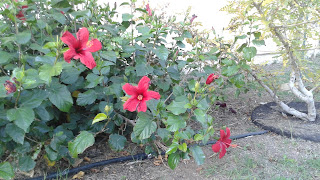The first definition I described in part 1 focused more on the form of the forest (especially spatial characteristics); the second definition focuses more on function.
food forest2 an intentional assembly of trees and other plants that uses interactive diversity, vertical stacking (spatial strategy), and managed succession of species (temporal strategy) for the purpose of producing food and other products.Yes, its form ends up being dense and reminiscent of a forest just like the first definition, but under the second definition this result is as incidental as it is unsurprising. The first definition describes a static forest at climax (equilibrium) while the second also encompasses the natural dynamics that lead to climax.
How does the difference in definitions affect the process of starting a food forest? For us, we have seen a difference in imported vs. recycled nutrients, species composition (and how that changes over time), planting density (and how that changes over time), and the mechanisms used to nurture soil life.
We started the first section of our food forest by applying wood chip mulch liberally and planting food trees as saplings. We applied compost and other organic fertilizers, and maintained the mulch layer by importing more mulch. With time, effort, and imported material, this section is approaching the point where it will supply all of its own mulch.
We started the second section by planting "pioneer" (mostly legume) support species from seed: ground covers, bushes, and trees. We covered these with a thin layer of straw mulch - just enough to slow evaporation and offer a little thermal insulation, but not too much to let some light through. We selected pioneer species 1) with a preference for native species, 2) to grow quickly without fertilizer, 3) to prepare the soil (many by fixing nitrogen), and 4) to tolerate pollarding or coppicing. If all goes well, by the time the annual ground cover dies out, the pioneer trees and bushes will have formed a low but tight protective canopy and start supplying woody mulch.
In the first section the soil life was slowly nurtured primarily by relying on a small but growing number of subsurface animals and fungi to carry nutrients from imported mulch and fertilizer down into the soil.
In the second section the soil life will be nurtured more quickly, primarily by relying on 1) live support plants to convert atmospheric gases into sugars and transport them down into the soil, and 2) symbiotically associated rhizobia (from the inoculants that we applied to the legume seeds) to convert atmospheric gases into subsurface fertilizers.
In the first section, we started with mostly productive trees planted at final forest density which slowly formed a canopy over 2-4 years, and now there's little room to add support trees.
In the second section, we're starting with an overly dense planting of support plants which will form a canopy within 3-4 months, and later we'll thin (pollard, coppice, or remove) them during strategic seasonal conditions to provide mulch and make room for productive trees.
I think I'll pause here for today, and maybe follow up with an entry about some detailed experimental strategies we used, including our support plant palette for a small Phoenix suburban site.











































